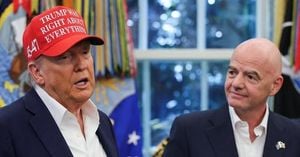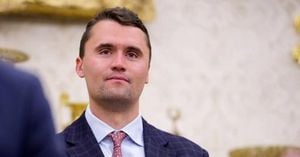In an eventful week for international diplomacy, senior officials from China and the United States engaged in two high-profile discussions—one on defense and the other on foreign affairs—that observers say could mark a turning point in the often fraught relationship between the world’s two largest economies. The exchanges come at a critical juncture, just days after China’s V-Day military parade and amid persistent tensions over trade, security, and regional influence.
On Tuesday, September 9, 2025, Chinese Minister of National Defense Dong Jun held a video talk with US Defense Secretary Pete Hegseth at Hegseth’s request, according to China Daily. This conversation was swiftly followed by a phone call on Wednesday between Chinese Foreign Minister Wang Yi and US Secretary of State Marco Rubio. Both sides described the communications as “timely, necessary, and productive,” underscoring a shared desire to keep diplomatic channels open despite ongoing disputes.
The Chinese Foreign Ministry emphasized that both countries must “further give full play to the strategic leading role of head-of-state diplomacy… properly manage differences, explore practical cooperation and promote the stable development of bilateral ties.” Wang Yi made it clear that recent US statements and actions had, in China’s view, “undermined China’s legitimate rights and interests” and “interfered in China’s internal affairs.” He added pointedly that such moves “are not conducive to the improvement and development of China-US relations,” a sentiment echoed in multiple Chinese media reports.
Wang’s remarks to Rubio included a call for the US to “exercise prudence in words and deeds,” especially when it comes to China’s core interests—most notably the Taiwan question. This message was reinforced during the defense ministers’ video talk, where Dong Jun reiterated China’s “bottom line” that the US must respect China’s core interests and stop what Beijing perceives as provocations regarding Taiwan and the South China Sea.
On the American side, the State Department’s readout highlighted that Rubio “emphasized the importance of open and constructive communication on a range of bilateral issues.” The Pentagon, meanwhile, noted that Hegseth had clarified the US does not seek conflict with China, nor does it aim for regime change or economic strangulation—a point intended to reassure Beijing of Washington’s intentions.
“No conflict and no confrontation” is not only a shared consensus but also a “bottom line for both countries and their militaries,” Dong told Hegseth, according to China Daily. That sentiment was echoed by Hegseth, who stressed, “the US does not seek conflict with China, nor is it pursuing regime change or strangulation” of the country. Still, he maintained that the US has “vital interests in the Asia-Pacific, the priority theater, and will resolutely protect those interests,” leaving open the possibility of continued US involvement in regional affairs.
Experts on both sides see these exchanges as a positive step. Diao Daming, a professor at Renmin University of China’s School of International Relations, told China Daily that “the two sides have maintained efficient, close high-level contacts on diplomatic and defense tracks,” sending a “positive signal to the rest of the world that Beijing and Washington are able to keep their communication channels afloat, steady and functioning.” Su Xiaohui, deputy director at the China Institute of International Studies, added that “the current top priority for Beijing and Washington is to follow through and take more actions to boost contacts, stabilize their ties and get the relationship back on track.”
Wang Yi also invoked history, reminding Rubio that China and the US “once fought side by side against militarism and fascism during World War II.” In his words, “In the new era, the two countries should likewise work together for world peace and prosperity, tackle global challenges and fulfill their due responsibilities as major countries.” He described China and the US as “two giant ships” that must “steadfastly adhere to the strategic guidance of their heads of state and fully implement the important consensus reached between the two leaders without any compromise.”
The flurry of diplomatic activity comes as exchanges at multiple levels between the two countries are showing signs of warming. US media reported that a bipartisan delegation from the US House of Representatives is planning a visit to China in September—the first such trip in six years. Earlier this month, descendants of the American “Flying Tigers” veterans participated in China’s V-Day military parade, a symbolic gesture that harkens back to the countries’ cooperation during World War II.
Economic ties remain a crucial and contentious part of the relationship. On Wednesday, the American Chamber of Commerce in Shanghai released its 2025 China Business Report, which revealed that nearly half of surveyed US companies want the US government to remove “all tariffs” imposed on Chinese goods. The report suggests that attempts to “decouple” the two economies have largely failed and that both sides recognize the mutual benefits of engagement. As China Daily noted, these “negative examples” of failed decoupling efforts are pushing Washington’s China policy back toward pragmatism and rationality.
Yet, despite the positive signals from high-level dialogue, underlying tensions persist. While seeking dialogue, Washington has not ceased its policies of containment and pressure, according to Chinese officials. Dong Jun warned during his talk with Hegseth that “acts of containment or deterrence against China will not succeed, nor will interference in China’s affairs.” Wang Yi, for his part, called on the US to “abandon zero-sum thinking and containment policy” and to “respond to China’s goodwill for cooperation.”
The context for these talks is a world in flux, with global turmoil and frequent regional hotspots making stable China-US relations all the more critical. Increased frequency of high-level communication, analysts say, not only reduces the risk of misunderstanding and miscalculation but also creates favorable conditions for addressing shared challenges like public security and stable supply chains.
For now, both sides appear committed to implementing the consensus reached by their heads of state—to “focus on peace and development, inject more stability and positive energy into the world, and make new contributions to peace and prosperity for humanity,” as Chinese officials put it. Whether these latest conversations will translate into concrete, lasting improvements remains an open question. But for a relationship that has often teetered on the edge of confrontation, even a cautious thaw is newsworthy.
As the two “giant ships” of China and the United States navigate the choppy waters of global politics, the world is watching closely to see whether dialogue can indeed steady the course toward a more stable and cooperative future.




